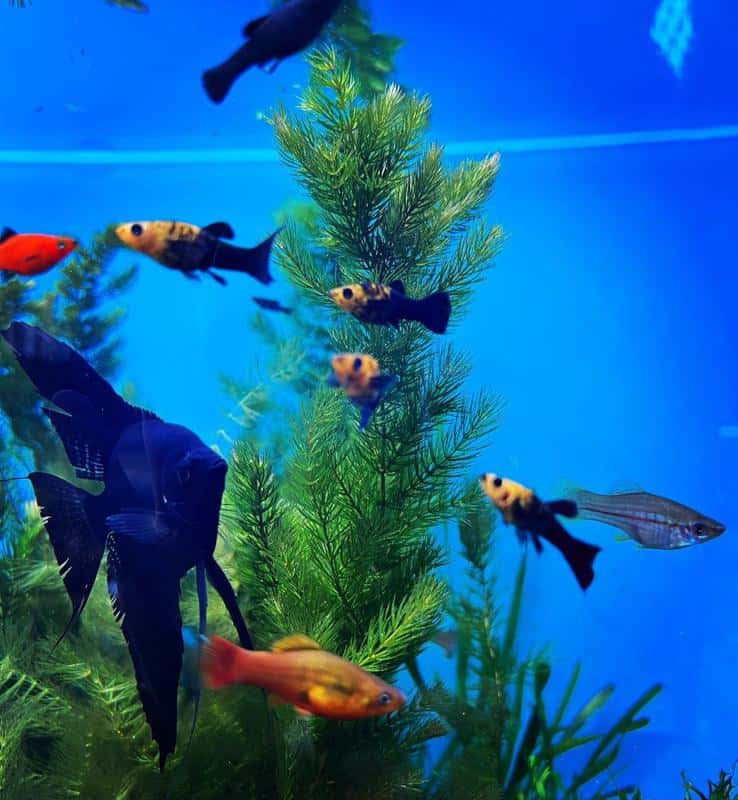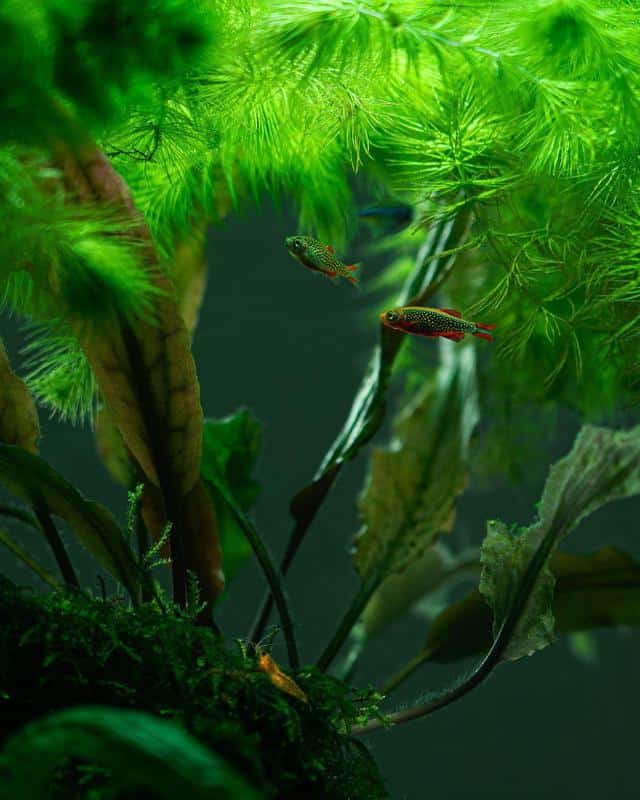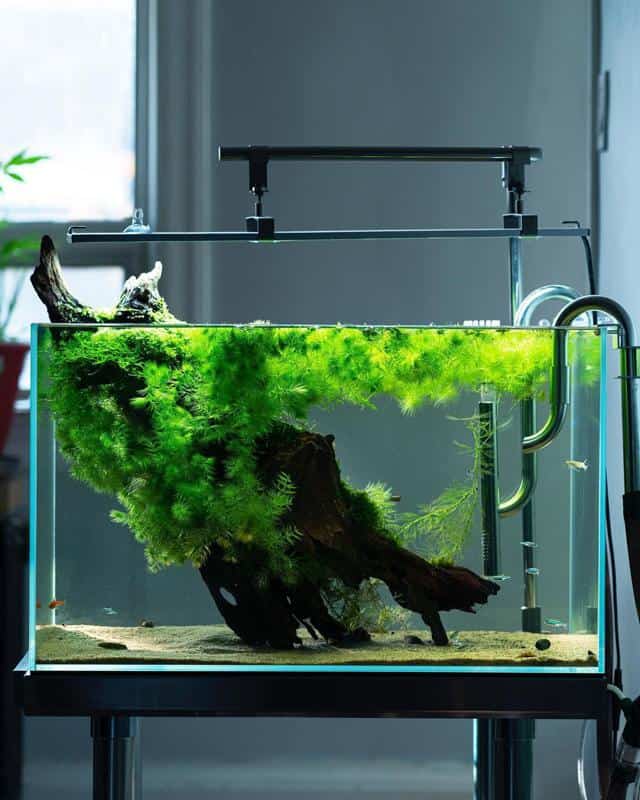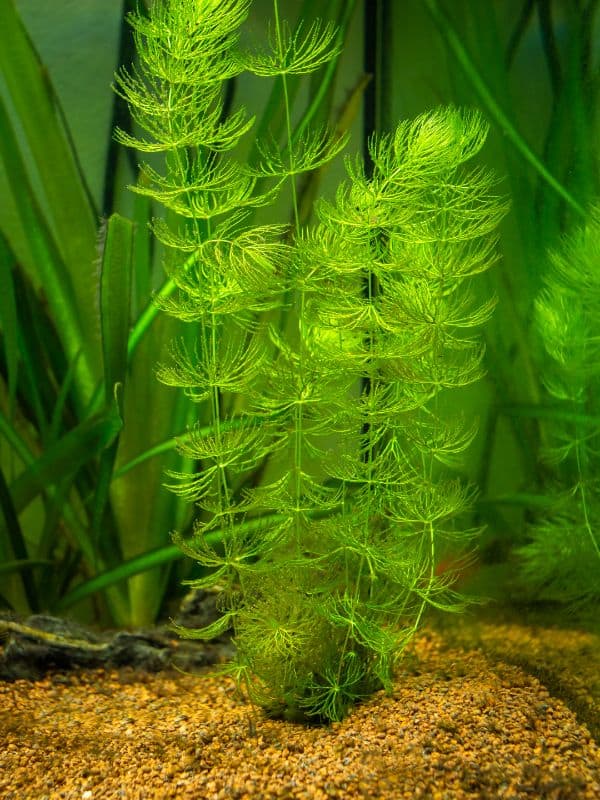Are you looking for a highly resilient, fast-growing, and functional aquarium plant that adds aesthetic beauty to your aquarium? Then consider planting a hornwort.
Consistently listed as one of the most commonly kept aquarium plants, Hornworts are so desired that they are kept and featured in cold-water tanks, warm-water tanks, and outdoor ponds.
But despite their popularity, only a few truly know what hornworts are, and in this article, we will feature everything there is to know about this distinct-looking aquarium plant.
Biological Characteristics
Global Coverage Except Polar Regions
Hornworts (Ceratophyllum demersum) are naturally thriving in all bodies of freshwater, except in the freezing Polar regions of the Arctic and the Antarctic.
From tropical to subtropical, Hornworts can survive a wide range of climate conditions making them a highly versatile aquatic plant. This is the reason why they are suitable for either cold-water or warm-water tanks. The fact is, Hornwort is one of the few aquarium plants that does not need a heating thermostat.
In the wild, they are often found in slow-moving waters with high nutrient concentrations. In effect, it creates a conducive environment for growth and may reach 7 meters in length.
Primitive Non-Vascular Bryophytes
Many of the biological features of Hornworts are still primitive. Being a bryophyte, Hornwort has no true roots. As a substitute, their bottom part has tiny filaments called rhizoids that allow the plant to anchor itself in the substrate or in any object.
Hornworts are also non-vascular plants. They lack specialized tissues (like most modern plants do) to transport water and nutrients within their body. Instead, they absorb nourishment directly through their leaves and transport them from cell to cell.
Overall, this is the reason why Hornworts are classified as column feeders. Knowing this by now, you should be ready to enrich your tank water with nutrient supplements for Hornwort to flourish and bloom.
Natural Floating Plants
The rhizoids in Hornwort are not as effective as compared to the true roots of other aquarium plants. There are cases of rhizoids rotting over time, which can lead to the uprooting of the plant.
It is why most aquarists attach them to driftwood or place them on pots if they want it to become bottom-dwelling plants.
Although they can be planted, Hornworts are best kept as floating plants. Aside from disregarding the possibility of having a rotting rhizoid, you are allowing the plant more light exposure and access to atmospheric carbon dioxide, which is a big booster for their growth.
Needle-Shaped Leaves

Unlike the leaves of most aquarium plants, Hornworts have thin and elongated leaves that taper to a sharp point at the end.
Their leaves are unbranched, have no veins, and are arranged to form a group with a circular pattern that runs along a central stem.
Although for the untrained eye, a Hornwort will look similar to Guppy Grass simply because of the similarities of their leaves. But in reality, they are different as the leaves of Guppy Grass are narrow and arranged oppositely on their stems.
The leaves of a Hornwort give off a feathery appearance that is visually pleasing and may serve as a refuge for tiny fish. Overall, their leaves look like a raccoon tail, thus its other name – Coontail.
Caution: Be careful when handling Hornwort. Their leaves are tender and can break off easily.
Effective Nutrient Absorber for Faster Growth
Like other aquarium plants, Hornwort absorbs nutrients in the water and uses them for plant growth. But what sets Hornwort apart from other aquatic plants is the amount of nutrients they can absorb.
Being a primitive and simple plant, it does not have complicated biological processes, and that is why they grow fast.
Each of their leaves absorbs nutrients directly in the water. The fact is, Hornwort absorbs a good amount of nutrients that allows the plant to grow up to 4 inches (10 cm) per week.
Emits Algae-Deterring Hormone
Algae, an unwanted specimen in our tank, grow when nutrients in the water are sufficient. With the nutrient-absorbing traits of Hornwort, it is already a deterrent for algae to grow.
However, what makes Hornwort so effective is its algae-deterring hormone. When released in the water, it eliminates algae presently populating your tank.
Planting Procedure

Hornworts are so versatile that you can keep them either as floating plants, bottom plants, or both.
As Floating Plants
As mentioned earlier, Hornworts are best kept as floating plants. In this way, you don’t need to worry about their rhizoids getting rotted.
While keeping them as floating plants may be as simple as placing them on the surface water, you still need to do some preparations.
Clean Before Stocking
Before stocking Hornwort in your tank, wash and clean them for dirt, debris, and other contaminants that may pollute your water.
Once cleaned, examine the plant closely and take away any rotting parts. Remember that rotting can lead to biodegradation and potentially disrupt your water chemistry.
Cut for The Ideal Length
Some of the Hornworts you are about to stock may have different lengths. Some are longer, while some are shorter than others.
It is not necessary to have a uniform cut upon stocking. Instead, establish an ideal length that is dependent on the size of your tank.
Do not stock Hornworts with lengths that can reach from end to end of your tank. It blocks the light and may impede the growth of other plants beneath it. Only stock Hornworts that have a quarter or a third of your tank length.
For example, 25 to 30 cm long hornworts are ideal for a 100cm long tank. In this way, you are giving space for their growth and will have ample time before you start trimming them.
As Bottom Plants
Aside from cleaning and cutting them into the ideal length, you should decide where to place them and become bottom plants.
If you want to plant hornwort in the substrate, do not bury their rhizoids. Otherwise, it will start to rot. Instead, clump together several stems and weigh them down using rocks, gravel, or sandy.
Overtime, their rhizoids will develop, and the plant will naturally anchor itself to the substrate. Placing them in small decoratrive pots will also do the trick.
Similarly, you can place and tie Hornworts in driftwood. With a little bit of art and landscaping, you can create a bushy Hornwort forest in no time.
Growth Requirements

Hornworts are easy to maintain and care for, making them great aquatic plants for newbies. But it doesn’t mean that you just leave them behind. You still need to maintain your tank parameters for this plant to show off its full blooming beauty.
Here are the growth requirements in keeping Hornworts.
| Parameters | Range |
| Substrate | Not necessary (gravel if rooted) |
| Light | Moderate |
| Water flow | Stagnant to Low |
| Temperature | 10 – 30 C (50 – 85 F) |
| pH | 6 – 8 |
| Hardness | 5 – 15 |
| Fertilizers | Low to Medium |
| CO2 | Low to Medium |
Pruning Procedure
Since Hornworts are fast growers, they need constant pruning.
Trimming your Hornwort is very easy and some have used their bare hands to cut and break off the part they want to trim. While you can do that, we do not recommend it.
Use stainless steel aquarium scissors. In this way, you will not damage their fragile leaves during pruning. Further, with the curvature of the scissor steel, you can easily navigate, cut and take off any rotting part of the Hornwort.
Be sure to take away the trimmings and any rotting parts.
Methods of Propagation
Hornworts propagate through sexual and asexual reproduction.
Asexual Reproduction
Asexual reproduction in Hornworts occurs by fragmentation. By simply cutting off a part of their stem (also called thallus), you can produce another plant.
After pruning a full-length Hornwort, you have the option to replant the trimmings in another aquarium. If you don’t have a spare tank to stock new Hornwort plantings, make sure to discard the trimmings properly and do not throw them away, especially in nearby freshwater bodies as they can grow and become invasive.
Sexual Reproduction
Hornworts are dioecious plants. It means that the males are separate from the female plants.
Regardless of whether being a male or a female plant, each Hornwort produces tiny flowers. These are the tiny pink-colored shells that grow on the coils of the leaves that newbies mistakenly identify as fish eggs.
Technically, what’s inside a Hornwort flower are not eggs, but spores that are released during sexual reproduction. Once the spores are released, it usually takes 3 months before baby Hornworts start to appear.
Sexual reproduction of Hornwort is only successful in the wild. Although it still happens in an aquarium setting, its success rate is close to none.
Also Read:
FAQs
Do Goldfish Eat Hornwort?
Yes, but they will only attempt once. The reason for this is that the leaves of Hornwort are long and sharp at the edge.
Since goldfish have no teeth to chew on the Hornwort leaves, they swallow it whole. When it reaches their throat, it gets irritated, and it is why they spit it out on some occasions. In other words, while Goldfish are voracious plant eaters, Hornworts are an unpleasant food for them.
But still, goldfish can damage your Hornwort with their nuisance digging traits.
Do Leaves of Hornwort Regenerate?
Yes. The leaves of Hornworts are capable of regenerating if they are damaged or lost. Hornwort can recover quickly from damage through a process called vegetative reproduction.
Why Is My Hornwort Turning Yellow?
The leaves of Hornworts are naturally green-colored. However, in some cases, it can turn yellow, and there are two possible reasons for this discoloration.
First is too much light exposure. When you expose your Hornwort to intense and prolonged lighting, their leaves will turn yellow. We recommend you only expose them to moderate lighting for 6 hours a day.
Second, it can be associated with low-nutrients. The plant is not absorbing the right amount of nutrients and you need to add supplements, ideally liquid fertilizers and not root tabs.
Final Words
Hornworts are definitely resilient, adaptive and easy to care for. Newbies will not hesitate to try keeping them as one of their starter plants.
However, do not be overconfident with their hardy traits and just leave them behind. This was my mistake when I started in the aquarium hobby in which I disregarded my Hornwort and ended up with a dead plant.
Thankfully, I learned my lesson and after improving the care I have given my Hornworts, they are now aesthetically blooming, biologically functioning and ecologically serving as a new sanctuary for my baby fish.

